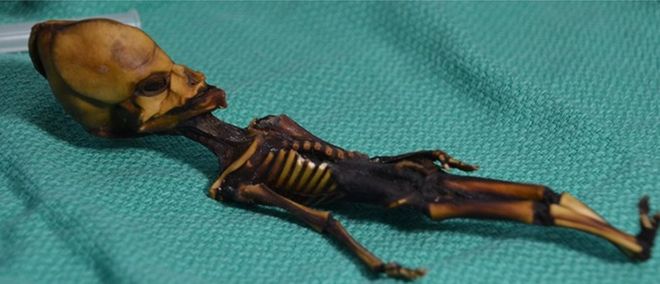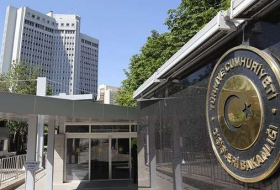Despite being the size of a foetus, initial tests had suggested the bones were of a child aged six to eight.
These highly unusual features prompted wild speculation about its origin.
Now, DNA testing indicates that the estimated age of the bones and other anomalies may have been a result of the genetic mutations.
Details of the work have been published in the journal Genome Research.
In addition to its exceptionally small height, the skeleton had several unusual physical features, such as fewer than expected ribs and a cone-shaped head.
The remains were initially discovered in a pouch in the abandoned nitrate mining town of La Noria. From there, they found their way into a private collection in Spain.
Some wondered whether the remains, dubbed Ata after the Atacama region where they were discovered, could in fact be the remains of a non-human primate. A documentary, called Sirius, even suggested it could be evidence of alien visitations.
Genetic investigation
The new research puts those ideas to rest.
A scientific team analysed the individual's genome - the genetic blueprint for a human, contained in the nucleus of cells.
They had already used this to confirm that the individual was human. Now, the team has presented evidence that Ata was a female newborn with multiple mutations in genes associated with dwarfism, scoliosis and abnormalities in the muscles and skeleton.
"What was striking and caused us to speculate early on that there was something strange about the bones was the apparent maturity of the bones (density and shape)," said Garry Nolan, a professor of microbiology and immunology at the Stanford University School of Medicine in California.
He told BBC News: "There was proportionate maturation of the bones, making the body look more mature despite the fact that the specimen was itself small. This discrepancy drove much of the research. So, we believe that one or more of the mutated genes was responsible for this."
The results revealed four new single nucleotide variants (SNVs) - a type of genetic mutation - in genes that were known to cause bone diseases, like scoliosis or dislocations, as well as two more SNVs in genes involved in producing collagen.
Ata also had 10 pairs of ribs, rather than 11 - a feature that has never been seen in humans before.
"We actually believe the girl was stillborn or died immediately after birth," said Prof Nolan.
"She was so badly malformed as to be unable to feed. In her condition, she would have ended up in the neonatal ICU."
However, access to advanced medical care was probably unavailable in the remote Chilean region where she was found. The skeleton's intact condition suggests it may be no more than 40 years old.
Future benefit
Prof Nolan began the scientific investigation of Ata in 2012, when a friend called saying he might have found an "alien".
He explained: "While this started as a story about aliens, and went international - it's really a story of a human tragedy. A woman had a malformed baby, it was preserved in a manner and then "hocked", or sold."
The scientists said that future studies of Ata had the potential to improve our understanding of the underlying basis of genetic skeletal disorders - with the potential to help others.
"Analysing a puzzling sample like the Ata genome can teach us how to handle current medical samples, which may be driven by multiple mutations," said Atul Butte, director of the Institute for Computational Health Sciences at the University of California, San Francisco.
"When we study the genomes of patients with unusual syndromes, there may be more than one gene or pathway involved genetically, which is not always considered."
Prof Nolan says further research into Ata's precocious bone aging could one day benefit patients. "Maybe there's a way to accelerate bone growth in people who need it, people who have bad breaks," he said. "Nothing like this had been seen before. Certainly, nobody had looked into the genetics of it."
He added: "I think it should be returned to the country of origin and buried according to the customs of the local people."
More about: mummy
















































